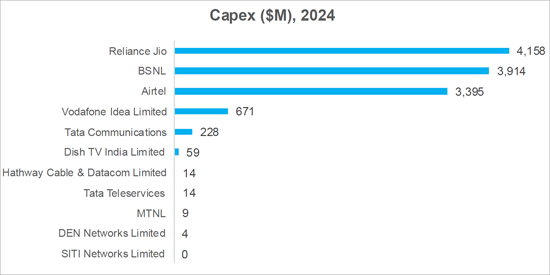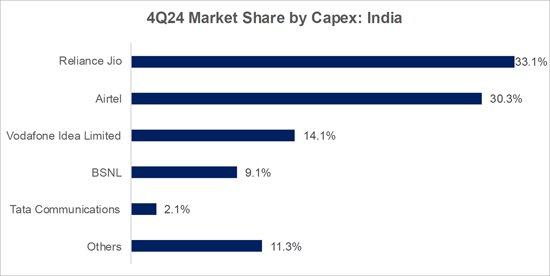PUBLISHER: MTN Consulting, LLC | PRODUCT CODE: 1738472

PUBLISHER: MTN Consulting, LLC | PRODUCT CODE: 1738472
India Capex Starts to Ease in 1Q25 after 3 Big Years
The government aims to develop a local ecosystem of suppliers able to build smart & secure communications networks without foreign help. More spending is needed to give the startups a boost.
This brief examines the near-term outlook for telecom capital expenditures (capex) in India, based on the 1Q25 earnings of key operators: Airtel, BSNL, Jio Platforms, and Vodafone Idea (Vi). It analyzes how current spending patterns compare with previous forecasts, highlights the main forces shaping investment decisions, explores implications for vendors, and discusses trends in emerging areas such as AI, large language models (LLMs), and data centers.
VISUALS
Figure 2: Major capex spenders in India,
CY24 versus 4Q24 ($M and % total)


Source: MTN Consulting
India closed 2024 with $14.0 billion in telco capex and $41.0 billion in revenues, representing 4.7% and 2.3% of global industry totals, respectively. India's capex to revenue ratio, or capital intensity, has remained above 30% for three straight years. Yet despite the sector's scale and strategic importance, most Indian telcos are now guiding capex downward over the next few years. That trend is aligned with our forecasts, but at odds with the Indian government's policy ambitions.
New policy initiatives aim to foster a vibrant domestic telecom tech ecosystem, better funded and more forward-looking than past efforts. But local startups developing next-gen telecom gear need real-world opportunities to test and refine their solutions. Those opportunities are set to shrink as telcos tighten their budgets to restore profitability.
Absent a shift in trajectory, India risks undercutting its own innovation goals. The most practical near-term solution? A government-led push for BSNL to deploy true 5G networks at scale, favorable treatment for Vi as it attempts to build out nationwide 5G, plus subsidies and other enticements aimed to make local Indian gear attractive to overseas buyers. That would help such Indian startups making waves like Astrome Tech, Coral Telecom, Frog Cellsat, Galore Networks, Niral Networks, Qbit Labs, Qnu Labs, Prenishq, Resonous Tech, Saankhya Labs, Scytale Alpha, Signaltron, Sooktha, VVDN, and WiSig.
Coverage
Organizations mentioned:
|
|
|
Table of Contents
Summary
Market background - India
1Q25 results
BSNL
Bharti Airtel
Jio Platforms
Vodafone Idea (Vi)
Appendix
List of Figures and Tables
- Figure 1: Capex forecast for India telco market and recent changes
- Figure 2: Major capex spenders in India, CY24 versus 4Q24 ($M and % total)
- Figure 3: BSNL capex, capital intensity, and share of global capex
- Figure 4: Airtel capex, capital intensity, and share of global capex
- Figure 5: Jio Platforms capex, capital intensity, and share of global capex
- Figure 6: Vodafone Idea (Vi) capex, capital intensity, and share of global capex




